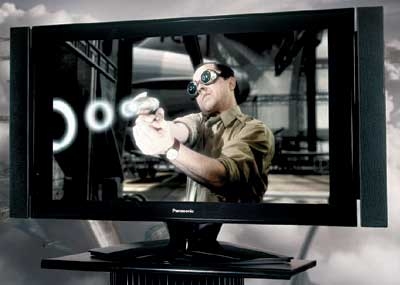Plasma Panorama Page 5
The TH-42XVS30U 42-inch plasma HDTV is the entry-level model in Panasonic's Onyx series, a line that also includes 50- and 65-inch sets. In this case, the "entry-level" price is $6,500, a big chunk of change even for a flat-panel TV. On the plus side, Panasonic cuts no corners with its Onyx TVs, tossing in all the up-to-the-minute technologies you could ask for: a digital cable-ready tuner with CableCARD, an SD/MMC card slot for viewing digital snapshots and video clips, and a PC Card slot that, with an optional adapter, will handle almost any other flash media you can think of, all in an external media receiver (back shown below). 
|
Onyx series HDTVs are among the best-looking plasmas you can buy - an evolutionary design leap over Panasonic's previous models. The front is virtually all glass, with a half-inch thin black metal frame running along the border. A sturdy, curvilinear base gives ample support, and with the lights dimmed, the effect is of a widescreen picture floating in the air (the optional wall mount costs $600 - ouch!). All A/V connections to the TV are handled by an external media receiver that connects via a supplied cable.
The matching black remote control has a fully backlit keypad and neat button layout that's organized around a central joystick for changing channels and navigating menus. One thing I missed was direct-input buttons for switching video sources - you need to toggle inputs by pressing the TV/Video button. Fortunately, you can streamline this process by deactivating unused inputs via the setup menu.
The options are surprisingly basic, but the set looked very good right out of the box (click to see "in the lab" PDF). One key thing that I found lacking was a custom picture memory for each video input. The workaround: modify the factory presets and remember which one to use when you switch sources - for example, the Movie preset for DVD. The TV also couldn't display native 720p-format high-def programs through either its component-video or HDMI input. With ABC, ESPN-HD, and Fox all producing programs in 720p (as opposed to the more common 1080i format), a high-end TV like this should handle it - especially since 720p excels with sports and other fast-action programs. 
Watching Sky Captain , I was impressed with the Panasonic's ability to deliver deep blacks and a decent range of shadow detail - something you don't often see on plasma TVs. For example, in a scene set in Dr. Jennings's dark laboratory, I could make out the intricate array of lab equipment in the background. The Panasonic's picture also looked smooth and clean with most sources. In the earlier scene where Dr. Jennings and Polly meet in the movie theater, the glow emanating from her face came across as a smooth gradation of dark-to-light tones. Movies looked a bit rougher when I used an S-video cable to connect my DVD player. Since the set has no 2:3 pulldown processing, diagonal edges in some scenes tended to break up into stair-stepped lines. My advice: use a good progressive-scan DVD player with this TV.
HDTV programs looked extremely good. The brightly colored garments of the Tibetan actors were stunningly rich in Seven Years in Tibet on Showtime-HD, with the red robes of the young Dalai Lama and his attendant monks looking particularly intense. But even with this outpouring of color, skin tones remained natural. In a scene where Brad Pitt and David Thewlis's characters skate on a frozen lake, their pink faces stood in stark contrast to the brownish skin of the Tibetans. High-def picture detail was also impressive, with the ornate textiles in the Dalai Lama's chamber coming through with excellent clarity.
With its TH-42XVS30U, Panasonic has given us a plasma TV to drool over. The set's sculptured looks and high-end video performance make it a top contender in the 42-inch-plasma TV race. At $6,500, the price is steep, but once you've shelled out the bucks, expect to smile every time you turn on the TV. PDF: Features ChecklistPDF: In the Lab
Flat TVs with screens 60 inches or larger are cool, but at the end of the day models in the 42-inch range are what most folks are looking to buy. After living with this moderate-size foursome of flat TVs for a couple of weeks, here's my take on them:
If you're tight on cash and seek an all-purpose TV for watching sports, reality TV, or whatever, the Vizio P42HDe's $2,499 price makes it an attractive option. With its $4,000 price tag and only marginally better video performance, HP's PL4245N isn't as sweet a deal.
Both Pioneer's PDP-4350HD and Panasonic's TH-42XVS30U TVs combine topnotch video performance with attractive styling and features, so serious home theater enthusiasts will be hard pressed to choose between them. But with its $5,500 price tag, the Pioneer is the better bargain. Now the question is, are you ready to bring your TV-watching into the 21st century?
- Log in or register to post comments
 PICTURE QUALITY
PICTURE QUALITY














































